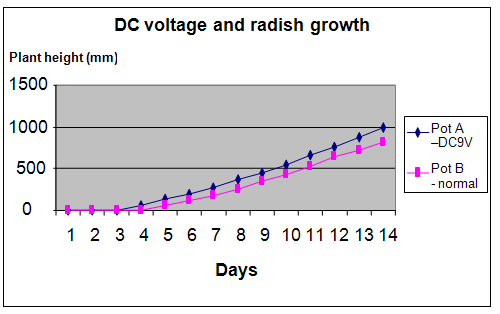| Complexity level: | 8 |
| Project cost ($): | 20 |
| Time required: | 1 day to prepare, 14 days for the science project experiment |
| Material availability: | Easily found |
| Safety concerns: | Be careful when handling batteries and electric currents. Adult supervision recommended |
Hypothesis
Radish seeds that are induced with DC voltages grow more quickly.
Overview
Electricity and plants
Electroculture involves the study of the effects of electricity and electric fields on the rate of seed germination and plant growth. This is an area of science where a lot of experimentation is being conducted. Researchers are starting to find evidence that plant growth can be enhanced by taking advantage of the sensitivity of plant cells to electric currents.
Observations have been made that certain types of grass appear healthier after a thunderstorm and grass that grows below an electric power cable generally look greener. However, these observations have been disputed by skeptics claiming that grass appear healthier after a thunderstorm as they have been given a good wash by the falling rain. As for the grass that grows under electric power cables, skeptics allege that the droppings from birds that sit on the power lines act help fertilize the grass.
Certain scientists suggest that while plants need all the known conditions such as sufficient sunlight, air, water and nutrients to grow, the presence of an electric current help to enhance plant growth. However, if the other conditions are not available, the presence of an electric field will not make a difference.
Scientific Terms
Materials
The materials required for this science fair project:
- 1 packet of radish seeds
- 2 plastic pots
- 2 copper rods
- Soil required for the 2 pots
- A DC 9V battery
- A pair of crocodile clips
- Tap water
- Ruler (1 meter)
Procedure
1. For this science project, the independent variable is the amount of electrical stimulation given to the plants. The dependent variable is the height of the radish plant. This is determined by measuring the height of the 10 plants in each group and calculating their average height. The constants (control variables) are the amount of water used, the amount of sunlight received and the type of plants used.
2. Two pots are labeled A and B. The same amount of soil is filled into both the pots. Ten radish seeds are then planted in each of the pots. (More than 10 radish seeds can be planted and the extra seeds that germinate can be removed later). The radish seeds that are planted in the same pot should be placed at least 20mm apart from one another.
3. Two copper rods are planted in the soil of the pot labeled A. The copper rods should be placed at opposite sides of the pot and should not touch each other. The DC9V battery will be connected to the copper rods for 5 minutes everyday for the next 3 weeks.
4. Both pots are provided with the same amount of water twice a day. The pots are also placed in a location where they can receive the same amount of sunlight.
5. The height of the plants is measured once a week and their average height is calculated and recorded in the table given below.

Results
It was observed that the average height of the radish plant in pot A which was given the electrical stimulation was taller than the radish plants in pot B.
|
Average daily height of the radish plant (mm) |
||||||||||||||
|
1 |
2 |
3 |
4 |
5 |
6 |
7 |
8 |
9 |
10 |
11 |
12 |
13 |
14 |
|
|
Pot A – DC9V |
0 |
2 |
5 |
59 |
127 |
195 |
271 |
362 |
455 |
547 |
661 |
768 |
879 |
991 |
|
Pot B - normal |
0 |
0 |
0 |
3 |
52 |
113 |
171 |
245 |
341 |
437 |
529 |
634 |
729 |
815 |
The graph below represents the results of our science project experiment:

Conclusion
The hypothesis that radish seeds induced with DC electric voltages will grow more quickly, is proven to be true.
Many electroculture experiments are being done in laboratories to show that introducing an electric or magnetic field will enhance plant growth and seed germination. This method can be used in plant nurseries to improve the yield of plants being nurtured.
Also consider
Try to repeat the science project experiment by comparing the growth rate using different voltages like DC6V or DC12V.
The experiment can also be done by changing length of time of exposure to the DC current and comparing plant growth.
References
Electricity may play a role in plant growth - http://www.nytimes.com/1985/04/09/science/electricity-may-play-role-in-plant-growth.html
Electricity to induce plant growth - http://www.thehindu.com/thehindu/2000/03/30/stories/08300009.htm
What effect on plant metabolism and growth does electricity have? http://www.madsci.org/posts/archives/jun99/927642916.Bt.r.html

